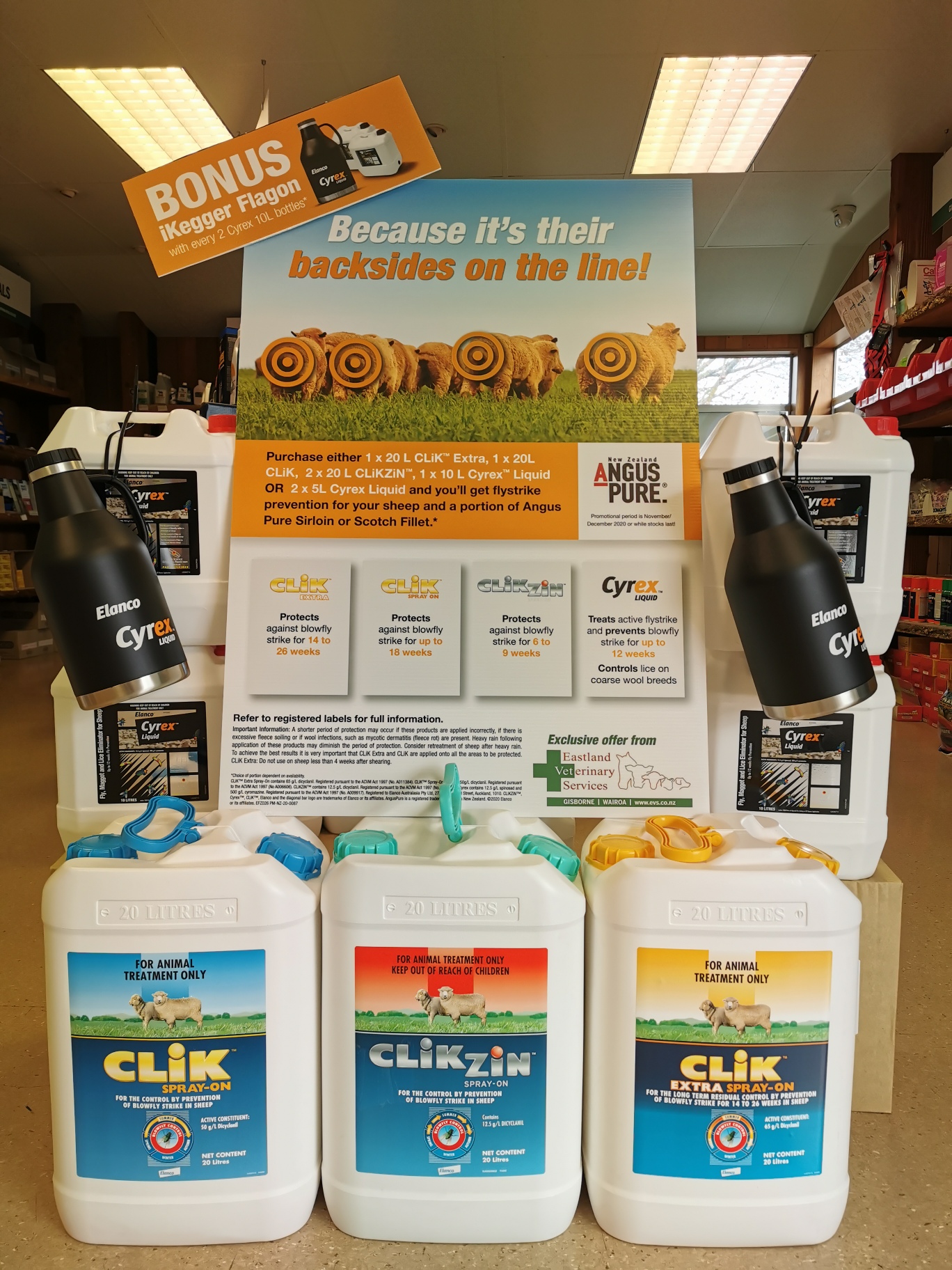743 Gladstone Road,
Gisborne 4040, PO Box 829
Phone - (06) 867 9405
Email - gisborne@evs.co.nz
46 Freyberg Street,
Wairoa 4160, PO Box 134
Phone - (06) 838 6099
Email - wairoa@evs.co.nz
<< News Headlines

Flystrike is the second most economically significant parasitic disease of sheep in New Zealand, ranking behind gastro-intestinal roundworms,
It is estimated flystrike costs the New Zealand sheep industry approximately $37 million per year in mortality, lost production, and treatment costs. Research has shown than even relatively small strikes can cause a marked reduction in feed intake and weight loss. Recovering this lost weight can take significant time. Anecdotal evidence suggests that ewes and ewe hogget’s struck in late summer/autumn are far less likely to get in lamb than non-struck animals. Four blowfly species can initiate strikes on sheep in New Zealand, with the Australian green blowfly (Lucilia cuprina) and the European green blowfly (Lucilia sericata) recognised as the most important sources of primary strike.
Chemical treatments
A wide range of chemical treatments that can be applied as saturation dips, pour-ons or spray-ons are registered for the prevention of flystrike in New Zealand. Nearly all of the commonly used products belong to the insect growth regulator (IGR) group of chemicals. While all IGRs interfere with the development of fly larvae, there are two different modes of actions within this group:
- Triazine/pyrimidine derivatives (e.g. cyromazine and dicyclanil)
- Benzoyl phenyl urea (BPU) compounds (e.g. diflubenzuron and triflumuron)
Cyromazine was first registered for use in NZ in 1988 as Vetrazin™ Spray-On, while dicyclanil has been available as CLiK™ since 1998. Dicyclanil is also the active ingredient in CLiKZiN™ (2009) and CLiK™ Extra (2017). Cyrex™ Liquid a combination of cyromazine and spinosad, has been available since 2010. Spinosad provides additional control of lice and knockdown control of maggots.
While the exact mode of action of the triazine and pyrimidine derivatives has not been fully determined, observations suggest that the first instar maggots are unable to complete moulting and development through to second stage larvae. These compounds have no effect against lice.
By comparison benzoyl phenyl urea compounds affect the deposition of chitin, a compound necessary for the formation of an insect’s cuticle. Chitin is a key component of the cuticle of all insects including lice. Diflubenzuron was first available as Zenith in 1991, followed by triflumuron as Zapp since 1998.
Prevalence of resistance in New Zealand
Lucilia spp. blowflies have demonstrated a remarkable ability to develop resistance to chemicals used to control or prevent flystrike. Resistance is first manifested as a shorter than expected period of protection, despite proper application and dosage. Studies and anecdotal reports suggest now widespread BPU blowfly resistance to Triflumuron particularly in the north western areas of the North Island. To date no reported resistance to the Triazine/pyrimidine derivative products such as Vetrazin™ and the CLiK™ range have been confirmed.
Resistance management
Resistance management now needs to be factored in when planning flystrike prevention programs, along with rainfall, class of sheep, shearing, docking, and weaning dates, product application method and previous fly challenge.
Unlike New Zealand, the Australian sheep industry has well-established guidelines for managing parasiticide resistance in blowflies and lice. The cornerstones of these programs include.
1) Always use an effective treatment
2) Apply preventative treatments before expected fly activity
3) Apply at the correct dose and using the correct application method
4) Do no use the same mode of actions for the control of flystrike and lice in the same season
5) Treat active flystrike with a different mode of action to the preventative treatment applied.
Flystrike poses a serious economic and animal welfare challenge for sheep and wool producers. Given the increasing complexity of sheep parasite management programmes, veterinarians have a key role to play to advising how to incorporate sustainable flystrike prevention into an overall animal health plan.
